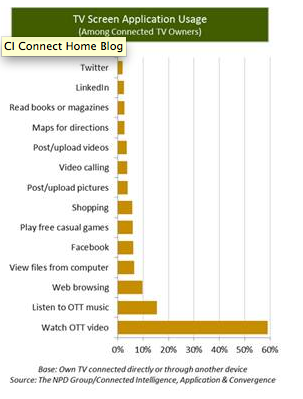The Internet connected HDTV screen has so far failed to break beyond the bounds of its TV-centric heritage, with little use for the big screen beyond the obligatory video services. But the connection is being used to provide access to a far wider variety of alternative sources for video content. The latest NPD Connected Intelligence Application & Convergence report highlights that nearly six out of ten consumers who own a connected HDTV are accessing Over-the-Top (OTT) video services through the device.
The decision is not for want of application choice, but rather seems to be focused on how consumers are used to interacting with their TV. HDTVs, gaming consoles, Blu-ray Disc players, and other connected devices offer an array of applications, ranging from Twitter and Facebook to web browsing. But, in general, these have failed to resonate with the audience, not least because there are better platforms, such as the PC, tablet, or smartphone, for such services. The one saving grace to-date has been music services, where the location of the TV and the availability of key music streaming apps such as Pandora has driven reasonable consumer uptake (roughly 15 percent).
The results are both good and bad news for TV manufacturers. On the positive side, the TV itself remains the fundamental screen for TV viewing within the home and is seeing an expanded array of programming through OTT services that supplement Pay TV subscriptions. The less than great news is that the TV manufacturers are failing to make the TV more than, well, a TV. Further, we are seeing attached devices also focus heavily on TV and video-centric apps, Microsoft’s upcoming launch of more than 40 additional television apps for the Xbox Live subscription service is one example.
It’s become clear that consumers want broadband content on their TV and that it will come through an array of devices. But will this screen evolve to become a hub for applications beyond TV and video programming?
The challenge may be that too much choice is creating a complex user experience. There are six or more types of devices bringing the Internet to HDTVs: the TV itself, video game consoles, Blu-ray Disc players, streaming media set top boxes, TiVo, and a few audio/video receivers. While 15 percent of HDTV displays are connected directly to the Internet, that number increases to 29 percent of HDTVs screens due to these other devices. This is driving the availability of around two connected eco-systems on the same TV screen, leading to a confused user-experience as consumers have more than one way of accessing their favorite TV apps.
An added wrinkle comes from the nascent trend towards “content throwing,” allowing programming to be transferred from the smartphone or tablet to the big screen. This is yet another challenge to the uniqueness of any one TV OEM’s device offering, especially as the throwing technology may also be driven by peripheral devices such as the Xbox. Indeed, the whole peripheral option, combined with emerging technology on specific OEM devices can lead to a host of complexities for consumers. Taking the “throwing,” screen-sharing concept as an example, there are multiple options emerging in the market, such as the Xbox SmartGlass, Samsung AllShare, Apple AirPlay, and many other DLNA variants.
As a result, it’s no wonder that most connected consumers are currently stopping short of exploring options beyond video. To counter this, OEMs and retailers need to focus less on new innovation in this space and more on simplification of the user experience and messaging if they want to drive additional, and new, behaviors on the TV.


